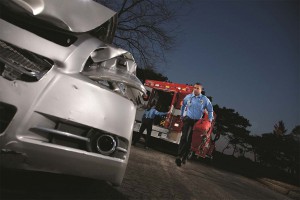When a 911 call comes in, there’s usually little first responders know beyond the fact that there’s been a car crash. But rescue crews are getting a critical leg up with the assistance of OnStar, which has been testing an algorithm designed to predict the type and severity of injuries crash victims may have suffered.
And a new study by the University of Michigan’s International Center for Automotive Medicine, or ICAM, indicates that the GM telematics unit’s Injury Prediction Service is proving to be an accurate indicator of what first responders will find – in the process making it possible to save more lives and more rapidly deal with injuries.
“With this data, we are able to much more accurately predict which people might be in this critical subset (requiring immediate emergency care) so that the proper resources can be deployed to rescue them and transport them to the right level of care,” said the study’s leader Dr. Stewart Wang.
(Federal safety officials want to mandate crash avoidance tech. Click Here for the story.)
The injury algorithm uses crash information, such as the force of a crash and the direction of impact to determine the likelihood of severe injuries to vehicle occupants, OnStar officials explain. That information is then relayed to 911 centers.
The system requires a motorist be driving a GM product sold in the U.S. and Canada equipped with OnStar and subscribing to the telematics operation.
“This past April we added injury severity prediction criteria to our trauma transport protocols,” said Cory Richter, battalion chief, Indian River County (Florida) Fire Rescue, in a statement released by OnStar. “It has been proven that crash victims with a severe injury have a better chance of survival when they’re transported to a trauma center instead of a local hospital. Resources like OnStar’s Injury Severity Prediction give us a better chance of identifying those victims early on.”
(NHTSA prototype could keep drunks off the road. Click Here for more.)
To show whether the Injury Prediction system work, U-Michigan researchers compared each prediction made by the OnStar algorithm with the corresponding police reports, medical records, EMS data and other information.
Researchers found that the predictions matched up with what was found by rescue crews and hospital medics.
The OnStar system has another potential benefit, according to General Motors. It can help validate the effectiveness of vehicle safety systems.
“With access to this information, our engineers can analyze today’s safety systems to identify those features most effective in preventing severe injuries in the future,” said Jeff Boyer, vice president, GM Global Vehicle Safety.
As a result of the study’s findings, GM says it will participate in efforts to train first responders around the country so they can use predictive injury data to adjust their own responses to a 911 call.
(New smartphone apps designed to keep drivers safer and in touch. Click Here for more.)


The predictive system sounds promising.
Unfortunately the data can also allow siren chasers to dupe naïve jurors into believing the auto maker is at fault for the poor decisions of the driver.